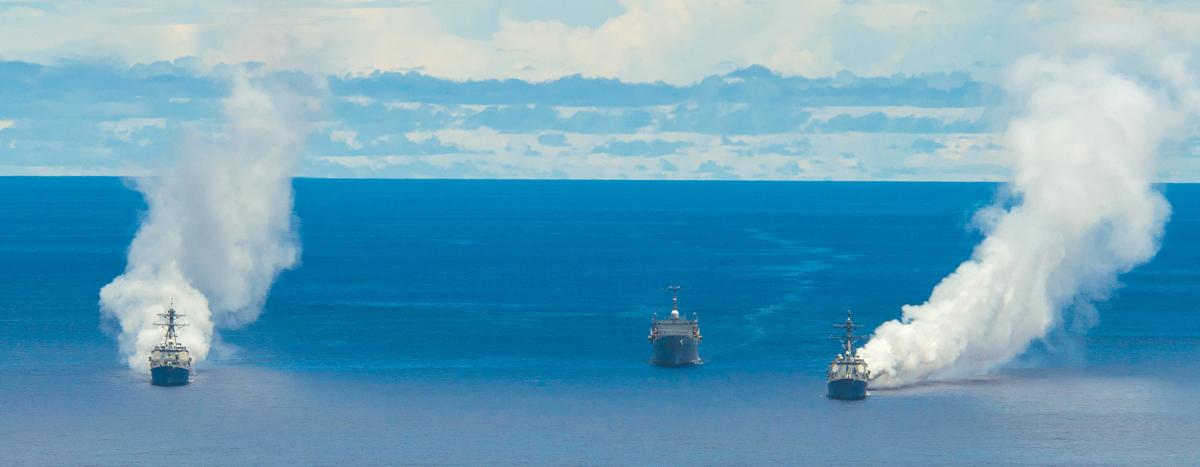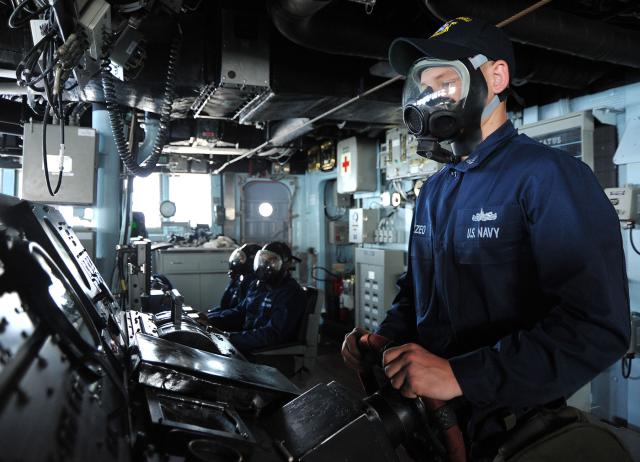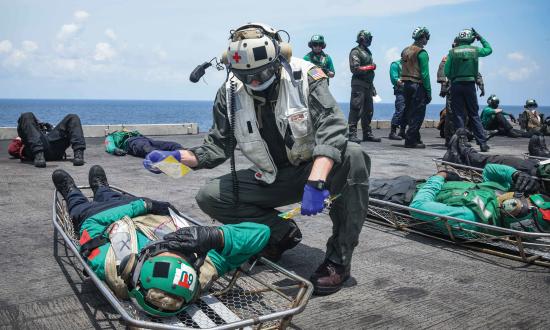Today, the U.S. Navy is embracing a disaggregated approach to warfare known as distributed maritime operations, dispersing ships over large areas to minimize the risks of targeting.1 This approach comes with an increased risk for ship commanders to find themselves tactically surprised. While smokescreens lost tactical relevance in the age of radar, their use today could play a decisive role in defending against enemy attacks. The old tactic of creating a multispectral fog should be reexamined in light of the proliferation of electro-optical and infrared (EO/IR) imaging systems, their incorporation into complex kill chains, and emerging nanotechnologies.
A Pressing Threat
Adversary intelligence, surveillance, and reconnaissance (ISR) networks are growing rapidly, and with them, the ability to target U.S. forces with long-range, over-the-horizon (OTH) weapons. Today’s fleet faces a multitude of guided weapons that use radar, antiradiation, EO, and IR seekers to home onto their targets. Some weapons are multispectral by using a combination of multiple seekers (radar, antiradiation, and IR), known as coherent seekers. While the Navy has developed systems and doctrine to limit the effectiveness of multispectral systems through disaggregation of forces, emission control, jammers, and chaff, limiting the optical element remains an anachronistic relic with only light discipline and haze-gray paint jobs dedicated to thwart any modern EO/IR systems.
Old Becomes New
Optical-only guidance systems have already unlocked autonomy in the weapons sector. In March 2021, reports speculated that Turkish STM Kargu-2 drones used optical imaging mated with machine learning to autonomously engage targets in Libya.2 Since optical systems are passive, adversaries only need to pair their systems with an image database and artificial intelligence (AI) to ensure proper target selection without alerting a target through radar emissions. For example, the European defense company MBDA Missile Systems developed AI to passively identify targets based on their visual and infrared signatures from weapon system sensors.3
In a way, what is old has become new. Emissions control can defeat antiradiation seekers while chaff can defeat active radar seekers. But against EO/IR seekers or sensors, emission control and chaff are useless. For close-in defense, this leaves only the ship’s short-range surface-to-air missiles, close-in-weapon system guns, and air-defense artillery. However, with an adequate warning, an effective smokescreen could thwart terminal guidance of EO/IR imaging systems and make the munitions revert to less-effective inertial or internal predictive guidance. With the rise of autonomous systems and AI, the threat of loitering munitions and persistent observation is growing. Preemptive and reactive smokescreens not only obscure immediate optical targeting, but may be enough to confuse AI algorithms so they misclassify the intended target, potentially neutering an attack before it can begin.
Deployment Mechanisms
In the age of dreadnoughts, biplanes demonstrated the effectiveness of an aviation-made smokescreen by dispensing titanium tetrachloride that created an “instantaneous wall of smoke large enough to hide a fleet behind.”4 However, historically ships have deployed smokescreens. Today, unmanned surface vessels (USVs) and aerial systems (UASs) promise to defend the fleet by dispensing chemical smokescreens in lieu of manned assets. UASs and USVs working together could be programmed to perform specific patterns and work in tandem to dispense chemical smokescreens over larger areas than manned surface assets ever could.
Some obscurants have been shown to weaken the transmission of parts of the electromagnetic spectrum other than visible and infrared radiation.5 Today, advances in technology make it possible to create chemical smokescreens that have radar-absorption properties.
In 2014, the Navy experimented with next-generation obscurant systems at sea in an exercise dubbed Pandarra Fog. Surface ships generated clouds filled “with carbon-fiber particles that could make it more difficult for antiship missiles to detect ships as well as hit them.”6 The test was deemed “very successful in terms of tactical employment, usability and cost effectiveness.”7
The U.S. Army explored the effectiveness of the obscurant titanium dioxide, among other agents.8 While titanium dioxide has been primarily attributed to blocking only the visible portion of the electromagnetic spectrum, recent scientific developments could make it just as relevant as the others.9 In 2019, the Journal of Materiomics published an article stating that aluminum/hydrogen treated titanium dioxide nanoparticles had a broad range of microwave absorption properties including in the S, C, X, and Ku frequency bands.10 These bands are used in a variety of search, acquisition, and weapon-seeker radars. A smokescreen infused with these nanoparticles would not only provide optical obscurants, but also could effectively blind radar seekers by absorbing radar emissions.11 Using these smokescreens in conjunction with obscurants that target the infrared spectrum holds promise to cloak the fleet against EO, IR, and different radars.
It’s Dangerous!
Despite the potential promise, critics will rightly point out that the smoke systems can be dangerous to the environment and the health of sailors. Dr. Hollis Williams, a professor of physics at Montgomery College, stated, “What is unknown about the [nanoparticle] study is the effects of breathing in a treated obscurant and its long-term health effects.” Titanium tetrachloride, a smoke-generating catalyst used during World War II, has acute and chronic effects ranging from corneal damage to chronic bronchitis.12 Even unburned hydrocarbons have been proven to be carcinogenic.13
While environmental and health concerns are valid, sailors are already trained to sail and fight in contaminated chemical, biological, and radiological environments. While any potential adverse health effects would need to be further studied, the potential loss of a warship with her crew in combat demands a reexamination of obscurant use.
New technology may make the smokescreen relevant, and the Navy should examine reincorporating it into the fleet. As the battlespace continues to incorporate more EO/IR sensors and weapons, the low-tech defenses of the past may still be effective.
1. Edward Lundquist, “DMO is Navy’s Operational Approach to Winning the High-End Fight at Sea,” Seapower Magazine, 2 February 2021; “Fiscal Year 2021 Department of the Navy Budget,” House Armed Services Committee,” 27 February 2020.
2. Hitoshi Nasu, “The Kargu-2 Autonomous Attack Drone: Legal & Ethical Dimensions,” Articles of War, Liber Institute, 10 June 2021.
3. “French Army to get AI System to Identify Enemy Vehicles,” The Defense Post, 23 December 2020.
4. Kyle Mizokami, “Watch: Airplane Makes Battleship Disappear with a Smoke Screen,” Popular Mechanics, 5 October 2020.
5. Committee on Toxicology, “Toxicity of Military Smokes and Obscurants: Vol. 2,” (National Research Council, 1999), 1.
6. Chuck Oldham, “Navy Tests New Radar-absorbing Obscurant,” Defense Media Network, 1 July 2014.
7. Oldham, “Navy Tests New Radar-absorbing Obscurant.”
8. Oldham, 1.
9. Oldham, 5.
10. Michael Green, et al., “Microwave Absorption of Aluminum/Hydrogen Treated Titanium Dioxide Nanoparticles,” Journal of Materiomics 5, no. 1 (March 2019): 25-32.
11. Dr. Hollis Williams, Professor of Physics at Montgomery College, interviewed by the authors, 30 July 2021.
12. Environmental Protection Agency, “Titanium Tetrachloride.”
13. Professor Kazuichi Hayakawa, “Burning Issue of Hydrocarbons, Impacts on Human Health,” Organization of Frontier Science and Innovation, Kanazawa University, 9 May 2014.







